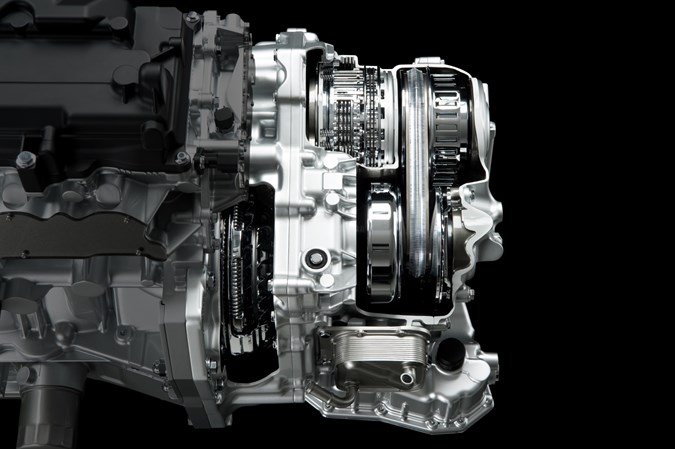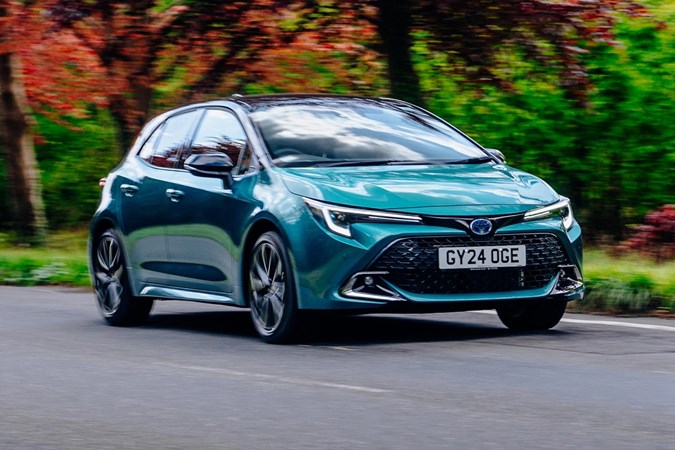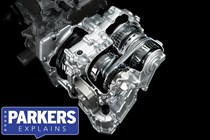You might think there are just two different types of car gearbox – manual and automatic. And you’d be right, at least as far as the UK’s driving license authority is concerned. While it’s true that all manual gearboxes are fundamentally the same, there are several types of automatic gearbox. The CVT – continuously variable transmission – is one of them and it’s most commonly found in hybrid cars.
In this article, we’re going to explain everything you need know about CVT transmissions including how they work, which cars have one and why, and what they feel like when driving. If you’d like to find out what some other car-related jargon and terminology means, head over to our glossary page.
How does a car’s gearbox work?
Before we get into how a CVT works, we need to first look at how a conventional gearbox operates and what its function is. In essence, a gearbox allows the car’s wheels to turn at a slower speed than the engine, and each individual gear lowers the speed at which the engine turns.
What does that mean in practice? Well, imagine the gears on a bike, linked by a chain. The gear connected to the pedals (the engine) is half the size of the one on the rear wheel. For every full rotation of the pedals, the wheel rotates half a turn. You travel slowly but the pedals turn with little effort – that’s first gear in a car.
Now image the gear at the pedals is twice the size of the wheel gear. For every full turn of the pedals, the wheel turns twice. It’d be really hard to set off, but once moving you can easily achieve high speed. That’s top gear in a car.

Of course, cars (and bikes) have more than two gears to allow easy running at a wide range of speeds. The inner workings of a gearbox are quite complex, with various cogs, shafts and rods that make up the gears the mechanism to shift between them. The gearbox is connected to the wheels via shafts and a differential that turns the rotating motion through 90 degrees to reach the wheels.
A conventional automatic gearbox operates on exactly the same principle. However, instead of there being cables and rods to disengage the clutch and shift between gears, hydraulics and solenoids do the work without any direct input from the driver.
So how does a CVT work?
A CVT also works without input from the driver, but the similarities with a conventional automatic gearbox end there. Instead of a series of gears, a CVT has a pair of pulleys – hence it being referred to as a transmission, not a gearbox. The pulleys are connected by a reinforced belt and the whole assembly to connected to the car’s wheels via shafts and a differential.

Rather than shift between gears, as engine speed increases the CVT’s pulleys increase in diameter. It’s the same principle as the bike: the relative size of the two pulleys – also known as the ratio – changes to match engine and road speed as efficiently as possible.
In theory, a CVT has a limitless number of ratios because the diameter or the pulleys is so variable. And that brings us to why a car would have a CVT.
What are the advantages of a CVT?
Fitting a conventional automatic gearbox to a car often reduces its efficiency by a significant amount. That’s because powering the hydraulics and electronics in an auto ‘box puts extra strain on the engine. Manufacturers have largely now got around that issue with clever software, but most are still a bit less efficient than an equivalent manual car.
Because CVTs don’t have power-sapping hydraulics, they put less strain on the engine and are therefore inherently more efficient. The theoretically infinite number of ratios between the pulleys in the CVT also means it’s able to stay in the most efficient ratio more of the time.

What does a CVT feel like to drive?
For decades, the CVT has been derided as providing at best a rather strange and at worst an unpleasant driving experience. That’s because the engine revs up to the point that matches how far you’ve pressed the throttle and stays there until the ratio catches up, eventually bringing the revs down.
If, for instance, you accelerate down a motorway slip road, the engine might rev up to 4,000rpm initially and then only come down once you’ve settled at 70mph and/or lifted off the throttle. 4,000 is a pretty raucous amount of revs in any car and the engine holding it for extended period can take some getting used to.

Things have changed for the latest generation of CVTs, though. Software simulates gearchanges that vary the engine revs for a more natural feeling – and sounding – driving experience. Indeed, the best are often smoother than a conventional automatic. They can still be a bit raucous if you accelerate hard, but the computers soon work out what’s going on and calm things down.
Which cars have a CVT?
Dutch carmaker DAF popularised the CVT with its range of city cars in the 1960s and 1970s before it was bought out by Volvo. As with any emerging technology, most car manufacturers soon came up with their own CVTs, but reliability issues and the oddness of the driving experience saw them fall from favour by the end of the 1990s.
But there was a hold-out. Toyota persisted with the CVT for its hybrid cars, because they’re more efficient than a conventional automatic. Honda followed suit for its hybrids and the two Japanese brands (plus Toyota offshoot Lexus) are now the main CVT exponents.
Just so you know, we may receive a commission or other compensation from the links on this website - read why you should trust us.












